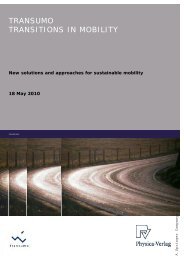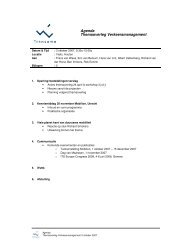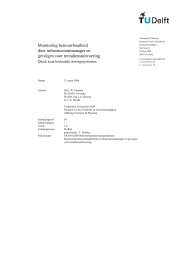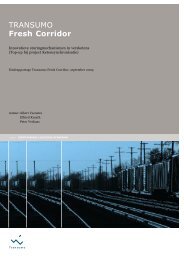Casestudie Breakdown prediction Contell PILOT - Transumo
Casestudie Breakdown prediction Contell PILOT - Transumo
Casestudie Breakdown prediction Contell PILOT - Transumo
You also want an ePaper? Increase the reach of your titles
YUMPU automatically turns print PDFs into web optimized ePapers that Google loves.
Interviews with several employees from the UMC St. Radboud discovered that<br />
currently no decision support does exist that introduces recommendations, telling<br />
what should be done in case of such an alarm. Not even information of time and<br />
duration of the last door opening is displayed to offer at least a hint on possible user<br />
influence. The only thing an employee can do in case of an alarm is to inspect the<br />
corresponding cooling device manually by having a short look at it.<br />
In fact, the very high quantity of false alarms led to a loss in credibility of XiltriX, so<br />
that employees tend to wait a certain time, after an alarm went off. Only in case of an<br />
enduring alarm for a longer time period or the occurrence of an uncommon high<br />
number of alarms during a short time interval, a manual inspection is really made in<br />
most cases. [Nijmegen06]<br />
As long as the stored contents are not damageable within very few minutes, this<br />
practice is doable. But the estimation, whether the developing of a current alarm is<br />
like most others or not, relies on experience and instinct of the operational staff. The<br />
suggested data mining method to classify the developing of an alarm into different<br />
alarming levels offers a higher reliability, because a decision, whether an alarm has<br />
to be classified as really critical, is based on all available information like door<br />
openings or past time behavior and not on unreliable user made estimations.<br />
Hence, in my point of view this classification method should be added to XiltriX to<br />
offer additional decision support and to reduce the number of demanded inspections.<br />
Highly critical devices may either be excluded from this classification or assigned with<br />
other classification parameters and additional conditions.<br />
<strong>Contell</strong>/IKS confirms the possible improvements but fears that this classification<br />
could lead to even higher user misbehavior, because classifications that are lower<br />
than the highest level might be ignored. Consequently, the current user behavior to<br />
wait for a certain time interval might be applied to the highest classification, so that a<br />
user reaction is delayed to an unacceptable level.<br />
The other major problem of sensor based temperature monitoring was the limited<br />
ability to recognize changes on the short- and long-run. Up to now, only changes are<br />
recognized that are bound to periodically occurring alarms. The suggested methods<br />
to use statistical analysis and regression to determine changes inside normal<br />
temperature range achieved a major improvement of this situation. Only the<br />
determination of an appropriate delta for different kinds of cooling devices still needs<br />
to be done in practice.<br />
103
















